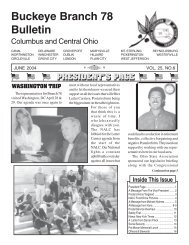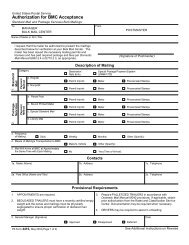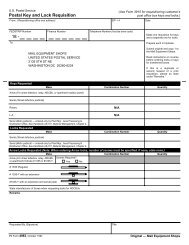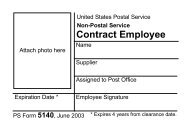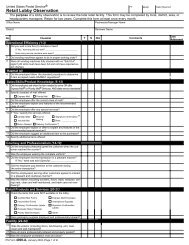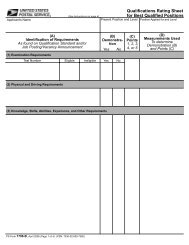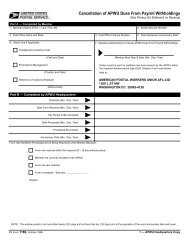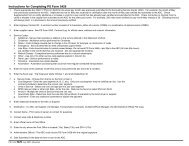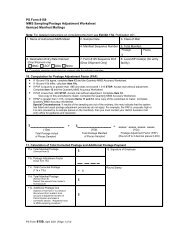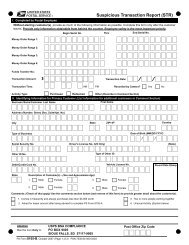Carriers in a Common Cause - 2006 - pp. 108-133 - NALC Branch 78
Carriers in a Common Cause - 2006 - pp. 108-133 - NALC Branch 78
Carriers in a Common Cause - 2006 - pp. 108-133 - NALC Branch 78
You also want an ePaper? Increase the reach of your titles
YUMPU automatically turns print PDFs into web optimized ePapers that Google loves.
FACING<br />
REVOLUTIONARY<br />
CHANGE<br />
F<br />
or well over a century, the job of a city carrier had<br />
hardly changed at all. True, carriers had switched<br />
from horse and buggy to motorized vehicle <strong>in</strong> the<br />
years s<strong>in</strong>ce the beg<strong>in</strong>n<strong>in</strong>g of city delivery <strong>in</strong> 1863.<br />
Nonetheless, by the end of the 1980s, carriers still cased all of<br />
their mail <strong>in</strong> the office before go<strong>in</strong>g out on the street. Changes<br />
<strong>in</strong> mail process<strong>in</strong>g <strong>in</strong> the preced<strong>in</strong>g decades, important <strong>in</strong><br />
<strong>in</strong>creas<strong>in</strong>g the overall efficiency of the Postal Service, had<br />
largely bypassed the work<strong>in</strong>g lives of letter carriers.<br />
As <strong>NALC</strong> began its second century, carrier work was revolu-<br />
tionized as optical character read<strong>in</strong>g and bar code scann<strong>in</strong>g tech-<br />
nology allowed the Service to arrange the mail <strong>in</strong> the sequence of<br />
delivery. By the beg<strong>in</strong>n<strong>in</strong>g of the 1990s, delivery po<strong>in</strong>t sequence<br />
mail, DPS for short, began to arrive at the carrier's case, result<strong>in</strong>g<br />
<strong>in</strong> the reduction of the amount of time carriers svent <strong>in</strong> the office<br />
A<br />
while conversely expand<strong>in</strong>g carriers' time on the street. Although<br />
the revolutionarv changes <strong>in</strong> how carriers verformed their work<br />
did not take plade oveAght and did not akect every delivery unit<br />
simultaneously, they affected labor relations on the workroom<br />
floor and at the negotiat<strong>in</strong>g table both positively and negatively.<br />
In fact, virtually every aspect of the relationship between the<br />
union and postal management felt the impact of DPS mail.<br />
CARRIERS IN A COMMON CAUSE Or 109
More than 1,000 <strong>NALC</strong><br />
members participated <strong>in</strong><br />
the AFL-CIO’s massive<br />
1991 Solidarity Day rally <strong>in</strong><br />
Wash<strong>in</strong>gton, DC <strong>in</strong> su<strong>pp</strong>ort<br />
of the American labor<br />
movement’s goals.<br />
For the <strong>NALC</strong>, there were two key<br />
issues: how would routes be structured<br />
as DPS made its slow but relentless<br />
entry <strong>in</strong>to the workplace, and what<br />
role would the union have <strong>in</strong> shap<strong>in</strong>g<br />
decisions concern<strong>in</strong>g DPS before these<br />
decisions were made. These questions<br />
were answered almost immediately, as<br />
management adopted, without the<br />
union’s <strong>in</strong>volvement or consent, a program<br />
ironically called “route stabilization”—or<br />
“6 and 2.” Under “route stabilization,”<br />
management planned to<br />
readjust, prior to the implementation<br />
of automation, all the routes <strong>in</strong> an<br />
office to conform to what management<br />
believed would be the workload both<br />
<strong>in</strong> the office and on the street once the<br />
amount of DPS mail arriv<strong>in</strong>g <strong>in</strong> the<br />
facility reached management’s target<br />
<strong>Carriers</strong> <strong>in</strong> a <strong>Common</strong> <strong>Cause</strong> 110<br />
figure. As a result, carriers’ street time<br />
would be extended and office time<br />
reduced—as would be the number of<br />
regular routes <strong>in</strong> the delivery unit.<br />
<strong>Carriers</strong> would no longer case all the<br />
mail they delivered—“routers” would<br />
case a sizeable portion of the mail the<br />
regular carrier would then deliver.<br />
As soon as “6 and 2” was <strong>in</strong>troduced<br />
<strong>in</strong> test sites around the country <strong>in</strong> the<br />
late 1980s, <strong>NALC</strong> strongly objected,<br />
<strong>in</strong>form<strong>in</strong>g management that route<br />
stabilization would delay the mail,<br />
disrupt operations and create chaos<br />
and low morale on the workroom floor.<br />
This proved to be the case as start<strong>in</strong>g<br />
times were moved back and carriers<br />
were compelled to deliver more and<br />
more mail later <strong>in</strong> the day or even<strong>in</strong>g<br />
to <strong>in</strong>creas<strong>in</strong>gly disgruntled customers<br />
In response to management’s<br />
unilateral<br />
readjustment of routes<br />
prior to the implementation<br />
of automation,<br />
<strong>NALC</strong> formed “truth<br />
squads” twice <strong>in</strong> the<br />
1990s to monitor the<br />
changes and ensure<br />
that branch representatives<br />
filed grievances<br />
whenever the adjustment<br />
did not conform<br />
to the contract.
unha<strong>pp</strong>y with the reliability of their<br />
mail service.<br />
As management proceeded to<br />
implement route stabilization over the<br />
union’s objections and <strong>in</strong> the face of<br />
customers’ compla<strong>in</strong>ts, the <strong>NALC</strong> realized<br />
it was time to draw a l<strong>in</strong>e <strong>in</strong> the<br />
sand. In December 1990 at his <strong>in</strong>stallation<br />
to a fifth term as <strong>NALC</strong> national<br />
president, V<strong>in</strong>cent R. Sombrotto<br />
announced that the union was form<strong>in</strong>g<br />
a cadre of “truth squads” throughout<br />
the country to monitor route<br />
adjustments and ensure that branch<br />
representatives filed grievances any<br />
time management adjusted routes<br />
without conform<strong>in</strong>g to the contract or<br />
those USPS manuals and handbooks<br />
that regulated route adjustments. The<br />
program itself—labeled “Best Efforts”<br />
as an offshoot of Sombrotto’s remark<br />
that carriers should give the Postal<br />
Service their “best efforts” but no more<br />
and no less—spread throughout the<br />
country dur<strong>in</strong>g 1991 and the first part<br />
of 1992.<br />
Despite the success of “Best Efforts”<br />
<strong>in</strong> giv<strong>in</strong>g branch representatives and<br />
rank-and-file carriers the tools to resist<br />
management’s efforts to deploy “6 and<br />
2,” no amount of logic or persuasion—<br />
or customer compla<strong>in</strong>ts—could deter<br />
management from proceed<strong>in</strong>g with<br />
the program. Not until the issuance <strong>in</strong><br />
July 1992 of a national-level arbitration<br />
award <strong>in</strong> a Hempstead, New York case<br />
did the dispute over route stabilization<br />
beg<strong>in</strong> a slow and tortuous path toward<br />
resolution. The decision held that<br />
management could not re-adjust<br />
routes solely to anticipate the future<br />
impact of delivery-po<strong>in</strong>t sequenc<strong>in</strong>g.<br />
Yet the arbitrator’s decision explicitly<br />
left critical issues for the parties to<br />
resolve themselves. This they successfully<br />
achieved <strong>in</strong> September 1992 by<br />
agree<strong>in</strong>g to six memorandums that<br />
established criteria for deal<strong>in</strong>g with<br />
grievances <strong>in</strong>volv<strong>in</strong>g past “Hempsteadtype”<br />
route adjustments. At the core of<br />
the memorandums were provisions<br />
halt<strong>in</strong>g all route adjustments based<br />
upon the anticipated impact of<br />
automation and an agreement that<br />
local management and <strong>NALC</strong> branches<br />
should reach decisions jo<strong>in</strong>tly on such<br />
key issues as case configurations dur<strong>in</strong>g<br />
route <strong>in</strong>spections, the creation of<br />
so-called “X-routes” to be phased out<br />
when a set amount of mail prepared <strong>in</strong><br />
delivery po<strong>in</strong>t sequence arrived <strong>in</strong> the<br />
delivery unit, and the hir<strong>in</strong>g of transitional<br />
employees. This new category<br />
of worker was <strong>in</strong>serted over the union’s<br />
objections <strong>in</strong>to the 1990 contract by<br />
an arbitrator after management had<br />
claimed the need for temporary<br />
employees dur<strong>in</strong>g the <strong>in</strong>troduction<br />
of delivery po<strong>in</strong>t sequenc<strong>in</strong>g.<br />
Sombrotto and<br />
management also<br />
agreed <strong>in</strong> late 1992 to<br />
give the a<strong>pp</strong>roximately<br />
30,000 part-time flexibles<br />
then on the rolls<br />
the o<strong>pp</strong>ortunity to<br />
convert to full-time<br />
status. In the summer<br />
of 1993, the union and<br />
management aga<strong>in</strong><br />
demonstrated the ability<br />
to work together by<br />
giv<strong>in</strong>g the more senior<br />
transitional employees an o<strong>pp</strong>ortunity<br />
to acquire career status. The parties<br />
also <strong>in</strong>corporated what they had<br />
learned <strong>in</strong> the field about DPS implementation<br />
<strong>in</strong>to a s<strong>in</strong>gle memorandum<br />
that also provided that the union and<br />
management would jo<strong>in</strong>tly test modified<br />
route <strong>in</strong>spections and adjustments<br />
at selected sites already receiv<strong>in</strong>g<br />
mail <strong>in</strong> delivery po<strong>in</strong>t sequence.<br />
Build<strong>in</strong>g on an extensive tra<strong>in</strong><strong>in</strong>g<br />
effort, jo<strong>in</strong>t route <strong>in</strong>spections were<br />
implemented throughout the country<br />
dur<strong>in</strong>g the fall of 1993. Simultaneously,<br />
<strong>NALC</strong> and management met at the<br />
national level to resolve a number of<br />
issues of critical importance to the<br />
<strong>Carriers</strong> <strong>in</strong> a <strong>Common</strong> <strong>Cause</strong> 111<br />
1990-2002<br />
At the 1993 Rap Session<br />
<strong>in</strong> Chicago, President<br />
Sombrotto and other<br />
national officers answer<br />
questions raised by carriers<br />
on automation issues<br />
<strong>in</strong>clud<strong>in</strong>g delivery po<strong>in</strong>t<br />
sequenc<strong>in</strong>g, part-time<br />
flexible conversions and<br />
the use of temporary<br />
employees.
<strong>NALC</strong> Food Drive<br />
Compassion toward their postal customers and service to<br />
their communities have been hallmarks of letter carriers<br />
throughout history. The early 1990s were no exception,<br />
for it was then that the <strong>NALC</strong> launched a venture that would<br />
quickly become one of the greatest examples of volunteerism<br />
<strong>in</strong> America—the annual <strong>NALC</strong> National Food Drive.<br />
For some time, a number of <strong>NALC</strong> branches had collected<br />
food for the needy locally on different days dur<strong>in</strong>g the year.<br />
To <strong>in</strong>crease participation and call greater attention to carriers’<br />
efforts, <strong>in</strong> October 1991, a pilot drive was held on the same day<br />
<strong>in</strong> 10 cities. This proved so successful that it was decided to<br />
expand the pilot program <strong>in</strong>to a nationwide effort. Input from<br />
food banks and pantries suggested, however, that late spr<strong>in</strong>g<br />
would be a better time because most food banks start runn<strong>in</strong>g<br />
out of the donations received dur<strong>in</strong>g the Thanksgiv<strong>in</strong>g and<br />
Christmas holiday periods. A revamped drive was organized for<br />
May 15, 1993—the second Saturday <strong>in</strong> May—and the results<br />
were astound<strong>in</strong>g. More than 220 union branches collected more<br />
than 11 million pounds of food as letter carriers from Alaska<br />
to Florida, Ma<strong>in</strong>e to Hawaii collected the donations while<br />
deliver<strong>in</strong>g their routes.<br />
With<strong>in</strong> a year, the <strong>NALC</strong> Food Drive had become the nation’s<br />
largest annual one-day drive. It ma<strong>in</strong>ta<strong>in</strong>ed this laurel with the<br />
participation of rural carriers, other postal employees and volunteers,<br />
as well as the su<strong>pp</strong>ort of the USPS and such groups<br />
as Campbell Soup Company; America’s Second Harvest, the<br />
nationwide food bank network; United Way of America and local<br />
United Ways; the AFL-CIO Community Services network; and<br />
Valpak, the national direct mail market<strong>in</strong>g firm. As a result, dur<strong>in</strong>g<br />
the <strong>NALC</strong> Food Drive’s first 13 years, carriers <strong>in</strong> over 1,400<br />
branches <strong>in</strong> more than 10,000 cities and towns <strong>in</strong> every state<br />
and jurisdiction su<strong>pp</strong>lied over a half-billion pounds of food to<br />
food banks and pantries, underscor<strong>in</strong>g the union’s historic<br />
commitment to serv<strong>in</strong>g carriers’ customers and communities.<br />
<strong>Carriers</strong> <strong>in</strong> a <strong>Common</strong> <strong>Cause</strong> 112<br />
implementation of DPS, <strong>in</strong>clud<strong>in</strong>g the question<br />
of how many bundles certa<strong>in</strong> carriers<br />
could carry.<br />
Unfortunately, the Service’s duplicity soon<br />
became evident as management abandoned<br />
agreements it had previously reached while<br />
also craft<strong>in</strong>g new proposals the union could<br />
never accept. First, the Service walked away<br />
from its agreement to give career o<strong>pp</strong>ortunities<br />
to transitional employees and then tried<br />
to force <strong>NALC</strong> to accept additional transitional<br />
employees <strong>in</strong> the city carrier craft. Not only<br />
did the union aggressively resist management’s<br />
efforts, but the bad feel<strong>in</strong>gs the<br />
Service engendered led to a breakdown of<br />
the ongo<strong>in</strong>g negotiations over the rules and<br />
guidel<strong>in</strong>es to govern the <strong>in</strong>troduction of<br />
delivery po<strong>in</strong>t sequenc<strong>in</strong>g <strong>in</strong>to the carrier<br />
workplace. In fact, once management fully<br />
understood the union would not agree to an<br />
expansion of the transitional employee workforce,<br />
it reversed itself on a number of other<br />
DPS-related issues where agreements had<br />
been reached, <strong>in</strong>clud<strong>in</strong>g the jo<strong>in</strong>t determ<strong>in</strong>ation<br />
of which routes would be elim<strong>in</strong>ated due<br />
to automation. Management also sent to the<br />
field <strong>in</strong> March 1994 DPS implementation<br />
<strong>in</strong>structions that unilaterally changed jo<strong>in</strong>tly<br />
agreed-upon <strong>in</strong>terpretations of the six<br />
September 1992 memos and also unilaterally<br />
changed, without proper notice, specific<br />
handbooks perta<strong>in</strong><strong>in</strong>g to work practices. In<br />
sum, management decided to implement<br />
DPS without the <strong>NALC</strong>’s participation and<br />
partnership.<br />
The <strong>NALC</strong> immediately responded by fil<strong>in</strong>g<br />
national-level grievances challeng<strong>in</strong>g the<br />
Service’s implementation <strong>in</strong>structions and<br />
also announc<strong>in</strong>g the creation of new “Truth<br />
Squad” tra<strong>in</strong><strong>in</strong>g to update the successful 1990<br />
“Truth Squad” route <strong>in</strong>spection program<br />
aimed at monitor<strong>in</strong>g and challeng<strong>in</strong>g management’s<br />
actions <strong>in</strong> the field. Moreover, the<br />
union cont<strong>in</strong>ued to ma<strong>in</strong>ta<strong>in</strong> that to reduce,<br />
if not virtually elim<strong>in</strong>ate, missed deliveries<br />
and “non-deliveries” <strong>in</strong>evitably result<strong>in</strong>g from<br />
an imperfect mail process<strong>in</strong>g automation<br />
program, carriers should case DPS mail until<br />
the volume was such that it would be <strong>in</strong>efficient<br />
and counter to the thrust of the Service’s
automation program for the carrier to<br />
cont<strong>in</strong>ue cas<strong>in</strong>g this mail.<br />
Management refused to deal with<br />
this issue, and <strong>in</strong> late February 1996<br />
ended abruptly and emphatically any<br />
discussions with the <strong>NALC</strong> about how<br />
best to shape the USPS automation<br />
program. The Postal Service’s disda<strong>in</strong><br />
for the contributions of the union and<br />
its members was hammered home<br />
just two months<br />
later when managementunilaterally<br />
withdrew<br />
from the 14-year<br />
jo<strong>in</strong>t Employee<br />
Involvement<br />
process, an act<br />
<strong>NALC</strong> protested<br />
to both the Postal<br />
Service and<br />
Congress.<br />
Management’s<br />
<strong>in</strong>creas<strong>in</strong>gly<br />
hostile attitude<br />
toward the union,<br />
coupled with its<br />
“go-it-alone” practices <strong>in</strong> adapt<strong>in</strong>g<br />
carrier work to the automation of mail<br />
process<strong>in</strong>g, cont<strong>in</strong>ued <strong>in</strong>to the midand<br />
late 1990s. In fact, <strong>in</strong> 1996, the<br />
Postal Service laid the groundwork for<br />
a massive violation of the collective<br />
barga<strong>in</strong><strong>in</strong>g agreement by unilaterally<br />
beg<strong>in</strong>n<strong>in</strong>g to plan, and <strong>in</strong> some cases<br />
implement, a number of test studies<br />
and pilot programs.<br />
Although employ<strong>in</strong>g different names<br />
and different statistical methods, the<br />
entire effort was most commonly<br />
referred to as “Delivery Redesign” and<br />
focused on three related goals: how<br />
carriers should be managed, how an<br />
eight-hour day should be def<strong>in</strong>ed and<br />
how letter carrier work should be<br />
organized. Essentially, the Service<br />
wished to comb<strong>in</strong>e old-fashioned timemeasurement<br />
studies designed to<br />
devise a time value for every possible<br />
physical movement of a letter carrier <strong>in</strong><br />
The Service’s disda<strong>in</strong><br />
for the contributions<br />
of the union and its<br />
members was hammered<br />
home <strong>in</strong> 1996<br />
when management<br />
unilaterally withdrew<br />
from the 14-year<br />
jo<strong>in</strong>t Employee<br />
Involvement process.<br />
<strong>Carriers</strong> <strong>in</strong> a <strong>Common</strong> <strong>Cause</strong> 113<br />
the office and on the street—an updated<br />
version of the ill-fated Kokomo<br />
experiments of the 1970s—with a related<br />
a<strong>pp</strong>roach that derived numerical<br />
values from exist<strong>in</strong>g data on carrier<br />
performance and route structures <strong>in</strong><br />
order to reorganize carrier work. The<br />
<strong>NALC</strong> immediately recognized that<br />
management was attempt<strong>in</strong>g to divide<br />
the membership and weaken the union<br />
by test<strong>in</strong>g and unilat-<br />
erally poll<strong>in</strong>g carriers<br />
to obta<strong>in</strong> <strong>in</strong>formation<br />
that could eventually<br />
speed up carrier work<br />
and undercut the<br />
union’s ability to<br />
defend its members.<br />
Immediately the union<br />
responded, <strong>in</strong>form<strong>in</strong>g<br />
both branch leadership<br />
as well as rankand-file<br />
members<br />
of management’s<br />
plans and encourag<strong>in</strong>g<br />
carriers,<br />
especially those<br />
who were be<strong>in</strong>g tested, to band<br />
together to resist any attempts by<br />
their supervisors to prod them to violate<br />
safety regulations or otherwise<br />
ignore the “fair day’s work for a fair<br />
day’s pay” pr<strong>in</strong>ciple enshr<strong>in</strong>ed <strong>in</strong> the<br />
collective barga<strong>in</strong><strong>in</strong>g agreement.<br />
Largely <strong>in</strong> reaction to the union’s<br />
resistance, management ste<strong>pp</strong>ed back<br />
from its plans to unilaterally <strong>in</strong>troduce<br />
new work standards and practices. In<br />
October 1997, the <strong>NALC</strong> and the Postal<br />
Service agreed to jo<strong>in</strong>tly test how to<br />
change carrier work to meet the future<br />
needs of the Service and the <strong>in</strong>evitable<br />
changes <strong>in</strong> the mail environment<br />
result<strong>in</strong>g from the explosion <strong>in</strong> electronic<br />
communications and commerce.<br />
Although specifically stat<strong>in</strong>g<br />
that the union was not a<strong>pp</strong>rov<strong>in</strong>g<br />
management’s Delivery Redesign<br />
programs or any tests management<br />
was implement<strong>in</strong>g unilaterally, the<br />
1990-2002
Letter carriers delivered an urgent message to<br />
the public nationwide on June 19, 1996:<br />
Mismanagement is ru<strong>in</strong><strong>in</strong>g the Postal Service.<br />
Above, <strong>Branch</strong> 36 members ignored w<strong>in</strong>d and<br />
ra<strong>in</strong> to demonstrate <strong>in</strong> New York City. At top,<br />
President Sombrotto jo<strong>in</strong>ed Wash<strong>in</strong>gton, DC<br />
<strong>Branch</strong> 142 members <strong>in</strong> an <strong>in</strong>formational picket.<br />
<strong>Carriers</strong> <strong>in</strong> a <strong>Common</strong> <strong>Cause</strong> 114<br />
compact recognized that for the Service<br />
to be efficient, productive and competitive,<br />
“it is <strong>in</strong> the <strong>in</strong>terests of both management<br />
and the union that the parties<br />
work cooperatively.” Two months later,<br />
the <strong>NALC</strong> Executive Council a<strong>pp</strong>o<strong>in</strong>ted<br />
branch presidents and rank-and-file<br />
carriers to a jo<strong>in</strong>t union-management<br />
task force to explore possible changes<br />
<strong>in</strong> the structure of letter carrier work.<br />
If the October 1997 accord demonstrated<br />
the will<strong>in</strong>gness of the Postal<br />
Service at the national level to cooperate<br />
with the union, managers <strong>in</strong> the<br />
field cont<strong>in</strong>ued to resist <strong>in</strong>clud<strong>in</strong>g the<br />
union <strong>in</strong> decisions affect<strong>in</strong>g how letter<br />
carrier work would be adapted to the<br />
new realities of DPS. This became obvious<br />
when, with carriers now wrestl<strong>in</strong>g<br />
with separate bundles of DPS mail and<br />
the mail they still cased, a national<br />
arbitrator ruled <strong>in</strong> the<br />
<strong>NALC</strong>’s favor by limit<strong>in</strong>g<br />
the number of<br />
bundles carriers <strong>in</strong><br />
certa<strong>in</strong> circumstances<br />
would have to carry<br />
but left to the parties<br />
the responsibility of<br />
implement<strong>in</strong>g the<br />
award. In response,<br />
<strong>NALC</strong> and management<br />
agreed to jo<strong>in</strong>tly<br />
study the relative efficiency<br />
of various work<br />
methods. Recogniz<strong>in</strong>g<br />
it would take time to complete the<br />
study, the parties directed local union<br />
leaders and their management counterparts<br />
<strong>in</strong> the <strong>in</strong>terim to select the<br />
most efficient a<strong>pp</strong>roach to handl<strong>in</strong>g the<br />
problem, but local managers ignored<br />
the agreement and refused to work<br />
with <strong>NALC</strong> branch leaders to reach<br />
mutually agreeable local solutions.<br />
Only after headquarters management<br />
<strong>in</strong>tervened and the <strong>NALC</strong> filed grievances<br />
did local managers toe the<br />
company l<strong>in</strong>e and cooperate with local<br />
union leaders.
Resolv<strong>in</strong>g<br />
Conflict<br />
at the<br />
Workplace<br />
If dur<strong>in</strong>g the 1990s, USPS Headquarters<br />
management occasionally<br />
reached out to <strong>NALC</strong>’s national<br />
officers to ease the <strong>in</strong>troduction of<br />
automation <strong>in</strong> the carrier workplace,<br />
local postmasters and supervisors <strong>in</strong><br />
many units rema<strong>in</strong>ed autocratic and<br />
adversarial. Management abuse, long<br />
pervasive <strong>in</strong> many facilities, only<br />
<strong>in</strong>creased as pressure to “make the<br />
numbers” to recoup the outlays for<br />
automation grew. As a result, the violence<br />
of historic proportions that<br />
began <strong>in</strong> the mid-1980s cont<strong>in</strong>ued <strong>in</strong>to<br />
the early 1990s, with the 1991 tragedy<br />
<strong>in</strong> Royal Oak, Michigan that took the<br />
lives of four supervisors and seriously<br />
wounded four craft workers hav<strong>in</strong>g the<br />
greatest fallout. Partly this was a matter<br />
of tim<strong>in</strong>g, s<strong>in</strong>ce it was the latest <strong>in</strong><br />
a str<strong>in</strong>g of tragedies. More important,<br />
supervisory harassment <strong>in</strong> Royal Oak<br />
had clearly been <strong>in</strong>tolerable, as even<br />
the most dis<strong>in</strong>terested observer was<br />
forced to admit.<br />
The Postal Service f<strong>in</strong>ally, if reluctantly,<br />
admitted that no matter how<br />
emotionally unstable the perpetrators<br />
of violence might be, the undue stress<br />
and tension <strong>in</strong> too many postal facilities<br />
had contributed to the violence<br />
that had erupted over the previous<br />
several years—and that could occur<br />
aga<strong>in</strong>. As a result, <strong>in</strong> late 1991, the<br />
<strong>NALC</strong>, the Service, two of the three<br />
other postal unions and all three<br />
supervisory organizations began<br />
meet<strong>in</strong>gs that led to an agreement the<br />
follow<strong>in</strong>g May to issue a statement<br />
Sombrotto had essentially drafted confront<strong>in</strong>g<br />
head-on the underly<strong>in</strong>g problem<br />
of management abuse. By sign<strong>in</strong>g<br />
the “Jo<strong>in</strong>t Statement on Violence and<br />
Behavior <strong>in</strong> the Workplace,” management<br />
acknowledged <strong>in</strong> black and white<br />
that it would take direct action to<br />
remove from their positions those<br />
<strong>in</strong>dividuals—management and craft<br />
employee alike—responsible for<br />
harass<strong>in</strong>g, threaten<strong>in</strong>g or bully<strong>in</strong>g<br />
employees.<br />
The lofty words of the Jo<strong>in</strong>t<br />
Statement and those of subsequent<br />
agreements had limited impact, for the<br />
Postal Service refused to take action<br />
aga<strong>in</strong>st supervisors and postmasters<br />
who threatened carriers and other<br />
craft workers. Although at first the<br />
<strong>NALC</strong> could do little to rid postal<br />
workplaces of abusive, if not necessarily<br />
violent, supervisors and postmasters,<br />
<strong>in</strong> August 1996 a national arbitrator<br />
ruled that by agree<strong>in</strong>g to the “Jo<strong>in</strong>t<br />
Statement on Violence and Behavior,”<br />
management had assumed a contractual<br />
obligation subject to the grievance-arbitration<br />
procedure. As a<br />
result, <strong>in</strong> a<strong>pp</strong>ropriate cases of management<br />
misconduct, arbitrators could<br />
order the Service to remove supervisors<br />
from positions where they supervised<br />
carriers or other craft workers.<br />
In the years that followed, <strong>NALC</strong><br />
branches filed scores of “violence and<br />
behavior” grievances at the local level,<br />
and a number of arbitrators directed<br />
the USPS to remove supervisors<br />
from positions supervis<strong>in</strong>g carriers<br />
and other craft workers.<br />
The <strong>NALC</strong> recognized that moderat<strong>in</strong>g<br />
the behavior of abusive managers<br />
was only one element, admittedly an<br />
important one, <strong>in</strong> creat<strong>in</strong>g a less contentious<br />
and stressful work environment.<br />
Another was that <strong>in</strong> too many<br />
facilities, management violated the<br />
collective barga<strong>in</strong><strong>in</strong>g agreement<br />
repeatedly, forc<strong>in</strong>g <strong>NALC</strong> branches<br />
to react by fil<strong>in</strong>g grievances. In these<br />
workplaces, grievances usually were<br />
pushed up the ladder, often to<br />
arbitration, thus creat<strong>in</strong>g backlogs of<br />
thousands of grievances. Justice was<br />
<strong>Carriers</strong> <strong>in</strong> a <strong>Common</strong> <strong>Cause</strong> 115<br />
1990-2002
By sign<strong>in</strong>g the “Jo<strong>in</strong>t<br />
Statement on Violence<br />
and Behavior <strong>in</strong> the<br />
Workplace,” management<br />
acknowledged <strong>in</strong><br />
black and white that it<br />
would take direct action<br />
to remove from their<br />
positions those <strong>in</strong>dividuals<br />
responsible for<br />
harass<strong>in</strong>g, threaten<strong>in</strong>g<br />
or bully<strong>in</strong>g employees.<br />
Efforts to end management’s<br />
repeated violations of the collective<br />
barga<strong>in</strong><strong>in</strong>g agreement<br />
were a major focus of the<br />
1997 Rap Session <strong>in</strong> Chicago.<br />
delayed and thus denied, simultaneously<br />
<strong>in</strong>furiat<strong>in</strong>g letter carriers and<br />
embolden<strong>in</strong>g managers.<br />
Resolv<strong>in</strong>g workplace disputes at the<br />
local level quickly—as well as prevent<strong>in</strong>g<br />
them from surfac<strong>in</strong>g <strong>in</strong> the first<br />
place—had long been<br />
a union objective.<br />
From the late 1980s<br />
on, the union encouraged<br />
jo<strong>in</strong>t experiments<br />
<strong>in</strong> the field to create<br />
new dispute resolution<br />
systems to resolve<br />
grievances fairly and<br />
expeditiously with the<br />
hope that the local<br />
parties would learn<br />
how to avoid problems<br />
<strong>in</strong> the future and thus<br />
develop a better relationship.<br />
An alternative<br />
dispute resolution<br />
process—the outgrowth<br />
of both the<br />
earlier experiments and top-level<br />
union-management discussions<br />
prompted by a 1994 Government<br />
Account<strong>in</strong>g Office report critical of<br />
postal labor relations—was tested<br />
beg<strong>in</strong>n<strong>in</strong>g <strong>in</strong> the late 1990s and, with<br />
then-Executive Vice President William<br />
H. Young shepherd<strong>in</strong>g and shap<strong>in</strong>g the<br />
process for the union, more than met<br />
the expectations of its proponents.<br />
The process had two major goals: to<br />
resolve grievances more quickly, thus<br />
<strong>Carriers</strong> <strong>in</strong> a <strong>Common</strong> <strong>Cause</strong> 116<br />
reduc<strong>in</strong>g the number of arbitrations<br />
clogg<strong>in</strong>g up the system, and to achieve<br />
greater contract compliance, thereby<br />
decreas<strong>in</strong>g the number of <strong>in</strong>cidents or<br />
occurrences giv<strong>in</strong>g rise to grievances.<br />
In essence, the grievance-arbitration<br />
procedure was reduced to two resolution<br />
steps prior to arbitration, with<br />
jo<strong>in</strong>t <strong>NALC</strong>-USPS dispute resolution<br />
teams charged with resolv<strong>in</strong>g grievances<br />
once the local parties had failed<br />
to do so. The success of this system<br />
was not <strong>in</strong>evitable, for without a common<br />
understand<strong>in</strong>g of the collective<br />
barga<strong>in</strong><strong>in</strong>g agreement, management<br />
and the union could f<strong>in</strong>d themselves<br />
mired once aga<strong>in</strong> <strong>in</strong> the grievancearbitration<br />
procedure. In 1998, the<br />
parties produced the Jo<strong>in</strong>t Contract<br />
Adm<strong>in</strong>istration Manual—JCAM for<br />
short—conta<strong>in</strong><strong>in</strong>g authoritative,<br />
agreed-upon <strong>in</strong>terpretations of the<br />
National Agreement that clarified contract<br />
language previously misunderstood<br />
and helped the jo<strong>in</strong>t resolution<br />
teams as well as <strong>NALC</strong> stewards and<br />
front-l<strong>in</strong>e managers resolve many<br />
disputes that earlier would have blossomed<br />
<strong>in</strong>to grievances. However, it<br />
was only when the alternative dispute<br />
resolution system was transformed<br />
<strong>in</strong>to a new Article 15 <strong>in</strong> the 2001-<strong>2006</strong><br />
National Agreement that the union<br />
reached the culm<strong>in</strong>ation of its lengthy<br />
struggle to ensure that justice was<br />
neither delayed nor denied.
At the<br />
Barga<strong>in</strong><strong>in</strong>g<br />
Table<br />
The impact of automation on<br />
the letter carrier workplace also<br />
dom<strong>in</strong>ated collective barga<strong>in</strong><strong>in</strong>g<br />
dur<strong>in</strong>g the 1990s—with the <strong>NALC</strong>,<br />
led aga<strong>in</strong> at the negotiat<strong>in</strong>g table by<br />
V<strong>in</strong>cent R. Sombrotto, committed to<br />
protect<strong>in</strong>g the work<strong>in</strong>g conditions of<br />
letter carriers <strong>in</strong> a more stressful environment<br />
while also ensur<strong>in</strong>g that carriers<br />
were fairly compensated for the<br />
additional physical and mental burdens<br />
they carried. For management, a<br />
lower-paid workforce with more parttime,<br />
short-term employees receiv<strong>in</strong>g<br />
fewer benefits was the goal. At each of<br />
the decade’s three rounds of negotiations,<br />
all resolved by an <strong>in</strong>terest arbitration<br />
panel after the parties were<br />
unable to reach agreements across the<br />
barga<strong>in</strong><strong>in</strong>g table, the Postal Service<br />
adopted a calculated strategy <strong>in</strong> su<strong>pp</strong>ort<br />
of its position on how automation<br />
should be implemented.<br />
At the 1990 negotiations, management<br />
first tried to use automation as a<br />
club to beat down the wages and bene-<br />
fits of barga<strong>in</strong><strong>in</strong>g-unit employees and<br />
weaken <strong>NALC</strong> and its long-time barga<strong>in</strong><strong>in</strong>g<br />
partner, the American Postal<br />
Workers Union. As its “f<strong>in</strong>al offer,” the<br />
Service put on the table proposals to<br />
<strong>in</strong>crease the number of part-time flexibles<br />
<strong>in</strong> large offices and expand the use<br />
of casuals—both part of its “flexibility<br />
proposal”—and create a two-tier wage<br />
system by slott<strong>in</strong>g new hires <strong>in</strong>to a<br />
totally separate pay schedule with a<br />
start<strong>in</strong>g wage—when <strong>in</strong>flation was<br />
taken <strong>in</strong>to account—that equaled<br />
postal wages <strong>in</strong> the late 1940s. In addition,<br />
management proposed reduced<br />
cost-of-liv<strong>in</strong>g adjustments, one-time<br />
lump-sum payments <strong>in</strong>stead of basic<br />
wage <strong>in</strong>creases, and a cap on the<br />
Service’s share of health <strong>in</strong>surance<br />
premiums. The <strong>NALC</strong> and the APWU<br />
immediately rejected these proposals.<br />
Although the arbitration panel that<br />
ultimately resolved the contract the<br />
follow<strong>in</strong>g year did not accept management’s<br />
most onerous wage proposals<br />
for exist<strong>in</strong>g employees, the panel<br />
clearly demonstrated its sympathy<br />
<strong>Carriers</strong> <strong>in</strong> a <strong>Common</strong> <strong>Cause</strong> 117<br />
1990-2002<br />
Top: President V<strong>in</strong>ce<br />
Sombrotto and<br />
Postmaster General<br />
Anthony M. Frank<br />
exchange contract<br />
proposals as<br />
negotiations for the<br />
1990 National<br />
Agreement beg<strong>in</strong>.<br />
When talks failed<br />
and the contract<br />
went to arbitration <strong>in</strong><br />
1991, then-Assistant<br />
Secretary-Treasurer<br />
Bill Young helped<br />
make <strong>NALC</strong>’s case<br />
(bottom).
Letter carriers gave the 1999 arbitrators a crash<br />
course <strong>in</strong> the “real world” of mail delivery <strong>in</strong> the<br />
automated Postal Service, <strong>in</strong>clud<strong>in</strong>g cas<strong>in</strong>g mail <strong>in</strong><br />
delivery po<strong>in</strong>t sequence versus pre-DPS (right) and<br />
the challenge of handl<strong>in</strong>g multiple bundles of mail<br />
dressed for w<strong>in</strong>ter weather. Below, <strong>NALC</strong> members<br />
testified about USPS on-the-street observation.<br />
for management’s desire for greater<br />
flexibility to accommodate the<br />
automation of mail process<strong>in</strong>g by<br />
expand<strong>in</strong>g the allowable number of<br />
part-time flexibles, and, more significantly,<br />
creat<strong>in</strong>g an entirely new<br />
category of temporary employee—<br />
transitional employees—to act as a<br />
“buffer” workforce until automation<br />
had progressed to the po<strong>in</strong>t that the<br />
Service could reduce its workforce.<br />
The 1994 negotiations and the<br />
ensu<strong>in</strong>g arbitration was a turn<strong>in</strong>g po<strong>in</strong>t<br />
<strong>in</strong> the <strong>NALC</strong>’s barga<strong>in</strong><strong>in</strong>g experience,<br />
for postal automation was creat<strong>in</strong>g an<br />
<strong>in</strong>surmountable wedge between the<br />
union and the APWU, lead<strong>in</strong>g to<br />
sharply diverg<strong>in</strong>g positions on key<br />
workplace issues. At <strong>NALC</strong>’s Atlantic<br />
City convention <strong>in</strong> 1994, delegates<br />
decided the union should “go it alone”<br />
at negotiations, then just days away.<br />
The wisdom of the delegates’ decision<br />
was validated at the 1995 arbitration<br />
that <strong>in</strong>evitably followed the<br />
<strong>Carriers</strong> <strong>in</strong> a <strong>Common</strong> <strong>Cause</strong> 118<br />
breakdown of negotiations when management<br />
<strong>in</strong>sisted on elim<strong>in</strong>at<strong>in</strong>g costof-liv<strong>in</strong>g<br />
adjustments, replac<strong>in</strong>g wage<br />
<strong>in</strong>creases with small one-time payments,<br />
elim<strong>in</strong>at<strong>in</strong>g step <strong>in</strong>creases and other<br />
regressive and totally unacceptable<br />
proposals. At arbitration, the <strong>NALC</strong> not<br />
only vigorously o<strong>pp</strong>osed the Service’s<br />
“give-back” proposals but also called<br />
upon the panel to settle the contract<br />
“on the basis of those criteria that<br />
a<strong>pp</strong>lied specifically to the letter carrier<br />
craft,” argu<strong>in</strong>g that delivery po<strong>in</strong>t<br />
sequenc<strong>in</strong>g—and especially management’s<br />
refusal to allow carriers to case<br />
DPS mail—had made the job of a letter<br />
carrier far more difficult, and, as a<br />
result, carriers should be upgraded<br />
from Grade 5 to Grade 6 on the wage<br />
structure.<br />
The arbitration panel was persuaded<br />
by many of the union’s arguments,<br />
but unfortunately sideste<strong>pp</strong>ed a number<br />
of automation-related issues. The<br />
panel rejected most of management’s
demands, <strong>in</strong>clud<strong>in</strong>g those for lower<br />
start<strong>in</strong>g salaries and the <strong>in</strong>creased<br />
use of transitional employees while<br />
grant<strong>in</strong>g carriers wage <strong>in</strong>creases <strong>in</strong><br />
addition to one-time payments and<br />
cont<strong>in</strong>u<strong>in</strong>g cost-of-liv<strong>in</strong>g adjustments.<br />
Unfortunately, the panel denied carriers<br />
Grade 6 pay. Tell<strong>in</strong>gly, the panel<br />
admitted that an upgrade should be<br />
favorably considered when DPS was<br />
fully implemented, itself an issue <strong>in</strong><br />
contention between the union and<br />
management. Four years later the true<br />
significance of this language became<br />
a<strong>pp</strong>arent—significance far greater than<br />
was fully a<strong>pp</strong>reciated at the time of the<br />
panel’s award.<br />
In 1998, the union aga<strong>in</strong> barga<strong>in</strong>ed<br />
alone. Negotiations between the <strong>NALC</strong><br />
and the Postal Service were cordial, but<br />
<strong>in</strong> the end money ruled, as management<br />
refused to grant the carriers<br />
a<strong>pp</strong>ropriate wages <strong>in</strong>creases. Yet<br />
despite the formal expiration of the<br />
exist<strong>in</strong>g contract, the parties cont<strong>in</strong>ued<br />
barga<strong>in</strong><strong>in</strong>g for an additional 90 days<br />
and then entered <strong>in</strong>to voluntary mediation.<br />
Still, management could not be<br />
persuaded to reward carriers adequately<br />
for what the union argued was a<br />
unique contribution to the Postal<br />
Service’s bottom l<strong>in</strong>e performed under<br />
<strong>in</strong>creas<strong>in</strong>gly adverse circumstances.<br />
As the mediator labored through the<br />
w<strong>in</strong>ter and <strong>in</strong>to the spr<strong>in</strong>g of 1999 to<br />
persuade the union and management<br />
to resolve their differences over the<br />
economic package, Sombrotto sent a<br />
message to the Postal Service. He<br />
reached out to the union’s members<br />
who, <strong>in</strong> response, loudly endorsed<br />
<strong>NALC</strong>’s position that, as a result of<br />
automation, they were work<strong>in</strong>g harder<br />
and under harsher conditions than<br />
ever before.<br />
Once the mediator acknowledged<br />
that he was unable to bridge the differences<br />
between the parties, thus sett<strong>in</strong>g<br />
the stage for <strong>in</strong>terest arbitration, the<br />
union took the next step—mount<strong>in</strong>g a<br />
nationwide “<strong>in</strong> your face” public relations<br />
campaign that culm<strong>in</strong>ated <strong>in</strong><br />
<strong>in</strong>formational picket<strong>in</strong>g <strong>in</strong> front of post<br />
offices throughout the country. The<br />
union’s message, aimed at both the<br />
public and management, was direct:<br />
due to automation, carriers were work<strong>in</strong>g<br />
harder than ever and deserved to<br />
be paid fairly for their efforts.<br />
When the arbitration hear<strong>in</strong>gs began<br />
<strong>in</strong> June, the union built its case around<br />
the language <strong>in</strong> the 1995 arbitration<br />
award suggest<strong>in</strong>g that an upgrade to<br />
Grade 6 should be favorably<br />
considered when DPS was fully<br />
implemented—which <strong>NALC</strong> argued<br />
had now been achieved. Moreover,<br />
the union argued that<br />
carrier wages compared<br />
unfavorably<br />
with those of workers<br />
perform<strong>in</strong>g similar<br />
work for the Service’s<br />
major competitors.<br />
The union’s case,<br />
however, rested ma<strong>in</strong>ly<br />
on the contention<br />
that DPS placed<br />
greater physical and<br />
mental demands on<br />
letter carriers —which<br />
the union effectively<br />
proved through the testimony<br />
of a variety of outside<br />
experts, national officers and<br />
key staff, but especially the<br />
first-hand accounts and<br />
hands-on demonstrations<br />
of rank-and-file carriers.<br />
Together these letter<br />
carriers educated the<br />
arbitrators about the<br />
physical wear and tear<br />
of extended time on the<br />
street, the great likelihood<br />
of <strong>in</strong>jury—especially <strong>in</strong><br />
<strong>in</strong>clement weather—the<br />
difficulties of balanc<strong>in</strong>g<br />
multiple bundles and carry<strong>in</strong>g<br />
heavier loads as well as addi-<br />
<strong>Carriers</strong> <strong>in</strong> a <strong>Common</strong> <strong>Cause</strong> 119<br />
1990-2002<br />
Informational<br />
picket<strong>in</strong>g <strong>in</strong><br />
June 1999<br />
demanded a<br />
fair contract.
Postal Record<br />
cover at left celebrated<br />
historic<br />
1999 arbitration<br />
decision that<br />
awarded Grade 6<br />
pay to letter carriers.<br />
Above, contract<br />
talks for a<br />
2001 National<br />
Agreement began<br />
with calls for a<br />
negotiated accord.<br />
9/11/01<br />
Like all Americans, letter<br />
carriers were deeply<br />
affected by the terrorist<br />
attacks of September 11,<br />
2001. Although none of<br />
the <strong>NALC</strong> members with<br />
World Trade Center routes<br />
were <strong>in</strong>jured, all had to<br />
cope with the knowledge<br />
that they would never see<br />
most of their customers<br />
aga<strong>in</strong>. At left, a <strong>Branch</strong> 36<br />
member opens a relay box<br />
covered with homemade<br />
fliers posted by New<br />
Yorkers seek<strong>in</strong>g word of<br />
miss<strong>in</strong>g loved ones.<br />
AP/WideWorld photo by Kathy Willens<br />
<strong>Carriers</strong> <strong>in</strong> a <strong>Common</strong> <strong>Cause</strong> 120<br />
tional problems—all a result of DPS.<br />
Sombrotto himself testified twice<br />
before the panel, highlight<strong>in</strong>g much of<br />
the previous testimony and argu<strong>in</strong>g<br />
that the panel should “de-l<strong>in</strong>k” carriers<br />
from “<strong>in</strong>side” workers represented by<br />
other unions. “Historic parity must<br />
yield to present reality,” he said,<br />
add<strong>in</strong>g that “otherwise you shackle one<br />
group of employees unfairly to the different<br />
problems faced by a different<br />
group of employees.”<br />
F<strong>in</strong>ally, <strong>in</strong> mid-September 1999, the<br />
panel issued an award that <strong>in</strong> addition<br />
to grant<strong>in</strong>g basic wages, cont<strong>in</strong>u<strong>in</strong>g<br />
cost-of-liv<strong>in</strong>g adjustments and improv<strong>in</strong>g<br />
health care benefits, elevated all<br />
Grade 5 carriers to Grade 6. Thus for<br />
the first time s<strong>in</strong>ce city delivery began<br />
<strong>in</strong> 1863, the pay scales of carriers were<br />
divorced from those of postal clerks.<br />
<strong>NALC</strong>’s advocates, officers, staff, expert<br />
witnesses and especially rank-and-file<br />
letter carriers had conv<strong>in</strong>ced the panel<br />
that as a result of delivery po<strong>in</strong>t<br />
sequenc<strong>in</strong>g, carriers were work<strong>in</strong>g<br />
both harder and smarter under more<br />
difficult conditions than ever—and<br />
certa<strong>in</strong>ly hard enough to deserve an<br />
historic pay upgrade.<br />
Perhaps as a result of the Grade 6<br />
decision, <strong>in</strong> 2001 management<br />
a<strong>pp</strong>roached negotiations for a new<br />
contract a<strong>pp</strong>ear<strong>in</strong>g to understand that<br />
<strong>in</strong>terest arbitration was not without<br />
risks. Or perhaps a more cooperative<br />
attitude was prompted by the crumbl<strong>in</strong>g<br />
of the World Trade Towers on<br />
September 11, only a little more than<br />
two months before the expiration of
the contract, as well as public anxiety<br />
about the safety of the mail stream<br />
after letters laced with anthrax, a<br />
potentially lethal bacteria, caused a<br />
number of deaths and illnesses only a<br />
few weeks later. Moreover, with DPS<br />
fully implemented and with automation<br />
no longer tak<strong>in</strong>g center stage, the<br />
most contentious issue of the 1990s<br />
was now quite literally off the table.<br />
Then too, the parties faced a common<br />
threat: the impact of the digital revolution<br />
cutt<strong>in</strong>g <strong>in</strong>to mail volume and, to<br />
an even greater extent, revenue.<br />
Whatever the reasons, barga<strong>in</strong><strong>in</strong>g<br />
for a new contract was by far the most<br />
productive <strong>in</strong> years, if not decades, and,<br />
after negotiations had been postponed<br />
for several months because of the<br />
anthrax attacks, <strong>in</strong> April 2002 the <strong>NALC</strong><br />
and the Postal Service reached an<br />
agreement that not only <strong>in</strong>cluded a fair<br />
economic package but also “codified”<br />
the alternative dispute resolution system<br />
the parties had been shap<strong>in</strong>g and<br />
ref<strong>in</strong><strong>in</strong>g for several years. Equally significant,<br />
the contract’s term would run for<br />
an unprecedented five years, both an<br />
overt bid by the parties to create a period<br />
of stability dur<strong>in</strong>g which they could<br />
work to strengthen the USPS’ long-term<br />
viability and a model for the other<br />
postal unions that soon built upon the<br />
<strong>NALC</strong>’s accomplishment.<br />
From<br />
Privatization<br />
to Reform<br />
By the time V<strong>in</strong>cent R. Sombrotto<br />
began his second decade as<br />
<strong>NALC</strong> president, the union had<br />
<strong>in</strong> place a sophisticated grassroots legislative<br />
and political network as well as<br />
a highly effective political action committee—the<br />
Committee on Letter<br />
Carrier Political Education, better<br />
known as COLCPE. To the extent possible<br />
with<strong>in</strong> the limitations of the 1939<br />
Hatch Act restrict<strong>in</strong>g active postal and<br />
federal employees’ participation <strong>in</strong><br />
national politics, the union’s grassroots<br />
operation worked to elect letter carrierfriendly<br />
members of Congress and<br />
communicate to elected representatives<br />
<strong>NALC</strong>’s views on legislation under consideration<br />
on Capitol Hill. COLCPE, too,<br />
was a remarkably powerful political<br />
weapon, draw<strong>in</strong>g upon the voluntary<br />
contributions of active and retired<br />
members to contribute to political<br />
campaigns and thus ga<strong>in</strong> a voice <strong>in</strong> the<br />
Congress when letter carrier <strong>in</strong>terests<br />
were at stake. The entire legislative and<br />
political operation was spearheaded by<br />
the union’s national officers and staffed<br />
by three Wash<strong>in</strong>gton-based legislative<br />
<strong>NALC</strong>’s legislative and political prowess beat back constant<br />
political attacks <strong>in</strong> the 1990s to underm<strong>in</strong>e the Postal<br />
Service and decimate postal benefit programs. <strong>NALC</strong><br />
President Sombrotto is shown testify<strong>in</strong>g before the House<br />
Government Reform and Oversight Committee <strong>in</strong> 1995.<br />
<strong>Carriers</strong> <strong>in</strong> a <strong>Common</strong> <strong>Cause</strong> 121<br />
1990-2002
and political professionals,<br />
su<strong>pp</strong>lemented by five rotat<strong>in</strong>g<br />
legislative <strong>in</strong>structors who<br />
organized the union’s grassroots<br />
field operations and<br />
tra<strong>in</strong>ed activists. This blend<br />
of a Wash<strong>in</strong>gton-based nerve<br />
center with vigorous membership<br />
su<strong>pp</strong>ort had enabled<br />
the union <strong>in</strong> the preced<strong>in</strong>g<br />
decade to repel the vast<br />
majority of legislative attacks<br />
on carrier benefits and<br />
programs set by law.<br />
Despite the union’s successes,<br />
constant political<br />
attacks on the Postal Service<br />
that underm<strong>in</strong>ed its f<strong>in</strong>ances<br />
and challenged its status as a<br />
public service and legislative<br />
threats to federal and postal benefit<br />
programs, especially those affect<strong>in</strong>g<br />
retirees, prompted the union to renew<br />
its campaign to free active carriers<br />
from the 1939 Hatch Act limit<strong>in</strong>g active<br />
postal and federal employees’ participation<br />
<strong>in</strong> the nation’s politics. Although<br />
active carriers could<br />
vote, Hatch Act restrictions<br />
prevented them<br />
from engag<strong>in</strong>g <strong>in</strong> virtually<br />
all other partisan<br />
activities. The <strong>NALC</strong> had<br />
long championed<br />
reform, if not outright<br />
repeal, of the Hatch Act<br />
and had almost<br />
achieved this goal <strong>in</strong><br />
1976. The union’s next<br />
best shot came <strong>in</strong> 1990<br />
In 2000 The Postal Record<br />
published a five-part series<br />
exam<strong>in</strong><strong>in</strong>g the challenges<br />
fac<strong>in</strong>g the Postal Service <strong>in</strong><br />
the 21st century. The series<br />
was compiled <strong>in</strong>to a booklet<br />
distributed at <strong>NALC</strong>’s 62nd<br />
Biennial Convention <strong>in</strong><br />
Chicago.<br />
<strong>Carriers</strong> <strong>in</strong> a <strong>Common</strong> <strong>Cause</strong> 122<br />
when, after President George H.W.<br />
Bush vetoed reform legislation and the<br />
House had overridden his veto, the<br />
Senate fell two votes short. Not until<br />
1993 was the union able to mount<br />
another serious run at Hatch Act<br />
reform. In September of that year, both<br />
houses of Congress a<strong>pp</strong>roved legislation<br />
grant<strong>in</strong>g active carriers the right to<br />
work <strong>in</strong> partisan campaigns, hold party<br />
office, serve as delegates to political<br />
conventions and speak out for the candidate<br />
of their choos<strong>in</strong>g. A few weeks<br />
later, President William J. Cl<strong>in</strong>ton<br />
signed the bill and Hatch Act reform<br />
was, at long last, a reality.<br />
In retrospect, Hatch Act reform was<br />
just one step, although a significant<br />
one, <strong>in</strong> the cont<strong>in</strong>ued development of<br />
the <strong>NALC</strong>’s legislative and political<br />
a<strong>pp</strong>aratus, allow<strong>in</strong>g the union to more<br />
effectively resist a revival of early<br />
assaults on the health and retirement<br />
benefits of postal and federal employees.<br />
“Un-Hatched” active members<br />
also helped the union combat<br />
renewed efforts to siphon off USPS<br />
funds to mask the balloon<strong>in</strong>g federal<br />
deficit—a maneuver <strong>NALC</strong>, the Postal<br />
Service and other postal groups had
een only partially successful <strong>in</strong><br />
resist<strong>in</strong>g. Although by the end of the<br />
decade, the government’s budget was<br />
<strong>in</strong> the black and Congress had less<br />
reason to deplete USPS revenues, the<br />
Postal Service rema<strong>in</strong>ed an easy target.<br />
Fortunately, <strong>NALC</strong>’s legislative<br />
and political prowess beat back<br />
repeated efforts <strong>in</strong> the late 1990s by<br />
congressional representatives allied<br />
with the USPS’ competitors to compel<br />
the Service to raise its prices as well<br />
as refra<strong>in</strong> from offer<strong>in</strong>g specific products<br />
to the public.<br />
The passage of Hatch Act reform<br />
also enabled the union to turn its legislative<br />
attention to other issues<br />
besides combat<strong>in</strong>g repeated<br />
onslaughts by those hostile to worker<br />
<strong>in</strong>terests, the USPS itself, or both.<br />
President Sombrotto was conv<strong>in</strong>ced<br />
that for the Postal Service to survive<br />
well <strong>in</strong>to the 21st century, reform of<br />
the outdated Postal Reorganization<br />
Act of 1970 was a necessity. In 1994,<br />
he publicly called for new legislation—“Postal<br />
Reorganization II”—<br />
to replace the exist<strong>in</strong>g statutory<br />
In honor of President V<strong>in</strong>cent R. Sombrotto’s<br />
retirement, a special display of memorabilia<br />
survey<strong>in</strong>g his career was on exhibit dur<strong>in</strong>g<br />
the 2002 convention <strong>in</strong> Philadelphia. Right, a<br />
group of delegates shows their a<strong>pp</strong>reciation<br />
for his years of service to letter carriers.<br />
structure and grant the Service the<br />
commercial freedom to compete fairly<br />
with the private sector and sufficient<br />
regulatory flexibility to react to<br />
chang<strong>in</strong>g economic and commercial<br />
conditions.<br />
Beg<strong>in</strong>n<strong>in</strong>g <strong>in</strong> 1996 and cont<strong>in</strong>u<strong>in</strong>g<br />
<strong>in</strong>to the new century, various reform<br />
bills were <strong>in</strong>troduced <strong>in</strong> the Congress,<br />
all shar<strong>in</strong>g the common goal of provid<strong>in</strong>g<br />
the USPS with the pric<strong>in</strong>g and<br />
product flexibility necessary to survive<br />
<strong>in</strong> an economy characterized by<br />
the rapidly <strong>in</strong>creas<strong>in</strong>g ability of citizens<br />
and bus<strong>in</strong>esses to communicate<br />
electronically and thus bypass the<br />
Postal Service entirely. Unfortunately,<br />
however, the Service’s competitors<br />
and others hostile to the survival of a<br />
public postal service successfully<br />
blocked reform efforts.<br />
In December 2002, as V<strong>in</strong>cent R.<br />
Sombrotto concluded his 24-year<br />
career as <strong>NALC</strong>’s national president,<br />
the postal reform legislation he had<br />
first advocated and long championed<br />
rema<strong>in</strong>ed an idea whose time had not<br />
yet come.<br />
<strong>Carriers</strong> <strong>in</strong> a <strong>Common</strong> <strong>Cause</strong> 123<br />
1990-2002
THE CHALLENGES<br />
OF A DIGITAL AGE<br />
y the time of William H. Young's <strong>in</strong>stallation as the Nm's 17th<br />
National President <strong>in</strong> December 2002, the impact of the digital<br />
revolution was <strong>in</strong>creas<strong>in</strong>gly a<strong>pp</strong>arent and <strong>in</strong>creas<strong>in</strong>gly trouble-<br />
some for both the union and the Postal Service. A comb<strong>in</strong>ation<br />
of electronic mail and electronic commerce was divert<strong>in</strong>g high-revenue<br />
mail from the postal mail stream, result<strong>in</strong>g <strong>in</strong> a decrease <strong>in</strong> first-class<br />
mail beg<strong>in</strong>n<strong>in</strong>g <strong>in</strong> 1998. Yet with the USPS deliver<strong>in</strong>g to 1.7 million new<br />
addresses each year, additional stra<strong>in</strong>s were cont<strong>in</strong>ually be<strong>in</strong>g placed on<br />
the Service's resource-and on letter carriers.<br />
What was truly cri<strong>pp</strong>l<strong>in</strong>g the Service, however, was the outdated Postal<br />
Reorganization Act of 1970, which limited the USPS' ability to compete<br />
fairly with its corporate rivals. The union's champion<strong>in</strong>g of legislation to<br />
grant the Postal Service more flexibility and commercial freedom had not<br />
yet borne fruit whenYoung took office, and the future of the reform effort<br />
was uncerta<strong>in</strong> at best. Although the <strong>NALC</strong> had <strong>in</strong> place a first-rate legisla-<br />
tive and political program to jump start the reform effort, the new NAU:<br />
president recognized that both the union's grassroots legislative network<br />
and its political action fund would have to be upgraded if the <strong>NALC</strong> were<br />
to be a major player <strong>in</strong> the emerg<strong>in</strong>g postal reform debate.<br />
CARRIERS IN A COMMON CAUSE 124
Ironically, electronic mail, one of<br />
the major threats to the Postal Service,<br />
proved to be a lifel<strong>in</strong>e for the union’s<br />
political activities. In 2003, the union<br />
created an “e-Activist” legislative<br />
network that could quickly generate<br />
e-mail messages updat<strong>in</strong>g e-Activists<br />
on the latest legislative developments.<br />
Through hyperl<strong>in</strong>ks to congressional<br />
offices, the network enabled<br />
e-Activists to communicate immediately<br />
to their congressmen and<br />
senators <strong>NALC</strong>’s positions on key<br />
legislative issues when called upon to<br />
do so. By the end of 2005, the union’s<br />
e-Activist database numbered almost<br />
68,000 <strong>in</strong>dividuals, augmented by<br />
another 71,000 legislative activists<br />
who could be mobilized through<br />
postal mail.<br />
S<strong>in</strong>ce money talks <strong>in</strong> politics, Young<br />
recognized that although the union’s<br />
political action fund—the Committee<br />
on Letter Carrier Political Education,<br />
also known as COLCPE—was one of<br />
the labor movement’s most productive<br />
fund-rais<strong>in</strong>g mach<strong>in</strong>es, <strong>in</strong>termittent<br />
direct mail solicitations did not provide<br />
the consistent stream of revenues<br />
required. In 2003 the union created<br />
the o<strong>pp</strong>ortunity for members to con-<br />
tribute to COLCPE directly us<strong>in</strong>g a<br />
variety of methods rang<strong>in</strong>g from payroll<br />
and annuity deduction to hav<strong>in</strong>g<br />
contributions drawn directly from<br />
check<strong>in</strong>g accounts. As a result of these<br />
regular and automatic ways of contribut<strong>in</strong>g,<br />
by the end of 2005 COLCPE<br />
was receiv<strong>in</strong>g a steady <strong>in</strong>flux of<br />
money, augmented by members’<br />
occasional contributions.<br />
Even before Young had upgraded<br />
and modernized the <strong>NALC</strong>’s<br />
grassroots and fund-rais<strong>in</strong>g capabilities,<br />
the union was presented<br />
with a new challenge <strong>in</strong> the<br />
debate over the future of the<br />
Postal Service when George W.<br />
Bush created the President’s<br />
Commission on the Postal Service<br />
<strong>in</strong> December 2002. For the <strong>NALC</strong>,<br />
Bush’s acknowledgment of the<br />
importance of postal issues and<br />
his awareness of the USPS’ longterm<br />
f<strong>in</strong>ancial problems was welcome<br />
news. That, however, the<br />
Commission might call for the<br />
privatization of the Postal Service, the<br />
elim<strong>in</strong>ation of Private Express Statutes<br />
and even the abolition of collective<br />
barga<strong>in</strong><strong>in</strong>g was of grave concern. As a<br />
result, Young drew a l<strong>in</strong>e <strong>in</strong> the sand <strong>in</strong><br />
In testimony before the Presidential<br />
Postal Commission <strong>in</strong> late April<br />
2003, <strong>NALC</strong> President William H.<br />
Young addressed labor relations<br />
and collective barga<strong>in</strong><strong>in</strong>g rights.<br />
<strong>Carriers</strong> <strong>in</strong> a <strong>Common</strong> <strong>Cause</strong> 125<br />
2003-2005<br />
A videotape mailed to every<br />
letter carrier <strong>in</strong> September<br />
2003 highlighted the serious<br />
dangers fac<strong>in</strong>g the USPS and<br />
threaten<strong>in</strong>g carriers’ futures.
As part of <strong>NALC</strong>’s effort to<br />
strengthen lobby<strong>in</strong>g clout, <strong>in</strong><br />
2003 the union created the<br />
o<strong>pp</strong>ortunity for members to<br />
contribute to COLCPE directly<br />
via payroll or annuity deduction<br />
or from their bank account.<br />
Above, San Bernard<strong>in</strong>o,<br />
California <strong>Branch</strong> 411 members<br />
sign up for payroll deduction.<br />
Leadership<br />
Academy<br />
early 2003. He <strong>in</strong>formed the<br />
Commission that <strong>NALC</strong>’s su<strong>pp</strong>ort for<br />
reform legislation depended not only<br />
on the Service be<strong>in</strong>g granted the commercial<br />
freedom to survive <strong>in</strong> a new<br />
and more challeng<strong>in</strong>g environment,<br />
but also that both the collective barga<strong>in</strong><strong>in</strong>g<br />
process and the Postal<br />
Service’s universal mandate to provide<br />
delivery to every household and bus<strong>in</strong>ess<br />
<strong>in</strong> America six days a week<br />
rema<strong>in</strong> <strong>in</strong>tact.<br />
Unfortunately, the Commission’s<br />
f<strong>in</strong>al report, although acknowledg<strong>in</strong>g<br />
that the Service must have greater<br />
<strong>Carriers</strong> <strong>in</strong> a <strong>Common</strong> <strong>Cause</strong> 126<br />
freedom to place its products and<br />
organize its core bus<strong>in</strong>ess, directly<br />
attacked the pay and benefits and<br />
collective barga<strong>in</strong><strong>in</strong>g rights of carriers<br />
and other craft employees. The<br />
<strong>NALC</strong> immediately declared its o<strong>pp</strong>osition<br />
to the barga<strong>in</strong><strong>in</strong>g recommendations<br />
as well as several of the<br />
Commission’s more regressive<br />
proposals while acknowledg<strong>in</strong>g that<br />
the report conta<strong>in</strong>ed some positive<br />
recommendations.<br />
As the <strong>NALC</strong> honed its views on<br />
postal reform and parried with the<br />
President’s Commission, President<br />
Young and the union’s legislative and<br />
research staff were strengthen<strong>in</strong>g the<br />
union’s alliances with other members<br />
of the postal community, primarily the<br />
organizations represent<strong>in</strong>g large mailers<br />
and top USPS management. These<br />
alliances produced immediate results<br />
early <strong>in</strong> 2003 when the U.S. Office of<br />
Personnel Management discovered<br />
that the Service had been “overpay<strong>in</strong>g”<br />
its obligations to the Civil Service<br />
Retirement Fund. OPM drafted legislation<br />
to change the formula used to<br />
<strong>NALC</strong> <strong>in</strong>itiated a national Leadership Academy <strong>in</strong> the<br />
summer of 2005 to nurture a new generation of union<br />
leaders. The first class consisted of 30 local activists<br />
selected from a pool of more than 300 a<strong>pp</strong>licants, each sponsored<br />
by a local mentor—<strong>in</strong> most cases, their branch president.<br />
Mentors had agreed both to help the tra<strong>in</strong>ees with the<br />
projects they would pursue back home <strong>in</strong> the time between<br />
the Academy’s three separate one-week sessions at the<br />
National Labor College <strong>in</strong> suburban Wash<strong>in</strong>gton and to cont<strong>in</strong>ue<br />
mentor<strong>in</strong>g them after the conclusion of the formal program.<br />
Subjects studied dur<strong>in</strong>g the three weeks of classroom<br />
sessions <strong>in</strong>cluded labor history, group dynamics, negotiat<strong>in</strong>g<br />
techniques, union f<strong>in</strong>ance and adm<strong>in</strong>istration, effective<br />
teach<strong>in</strong>g, written and spoken communication skills, postal<br />
economics, workers’ compensation and contract <strong>in</strong>terpretation.<br />
The Academy’s first class graduated <strong>in</strong> December 2005<br />
and another class of 30 activists began the program the<br />
follow<strong>in</strong>g January.<br />
At left, Executive Vice President Jim Williams facilitates<br />
discussion with leadership tra<strong>in</strong>ees.
calculate the USPS’ fund<strong>in</strong>g requirements.<br />
In su<strong>pp</strong>ort of the proposed<br />
legislation, the <strong>NALC</strong> secured the assistance<br />
of the major mailers and other<br />
allies <strong>in</strong> the postal communities and<br />
also mobilized its network of state<br />
legislative chairs, legislative liaisons<br />
and other letter carrier activists to take<br />
the union’s case to the Congress. As a<br />
result, a fund<strong>in</strong>g reform bill estimated<br />
to save the Postal Service $77 billion<br />
over 40 years emerged from Congress<br />
<strong>in</strong> late w<strong>in</strong>ter of 2003 and was signed by<br />
the president that April.<br />
Postal reform legislation did not ga<strong>in</strong><br />
the full attention of the Congress until<br />
2004 when both the House Government<br />
Reform Committee and the<br />
Senate Governmental Affairs Committee<br />
began to hold hear<strong>in</strong>gs on the issue,<br />
and Young testified before both bodies.<br />
In the spr<strong>in</strong>g, both committees unanimously<br />
passed reform legislation that<br />
unfortunately was never brought to<br />
the floor of either the House or the<br />
Senate dur<strong>in</strong>g the rema<strong>in</strong>der of the<br />
congressional session.<br />
However, reform legislation was<br />
re-<strong>in</strong>troduced <strong>in</strong> the Congress <strong>in</strong> early<br />
2005. By this time, the union, hav<strong>in</strong>g<br />
achieved a lead<strong>in</strong>g role <strong>in</strong> shap<strong>in</strong>g the<br />
legislative strategy of the postal community<br />
and strengthened its grassroots<br />
legislative activist network and<br />
political action fund, was <strong>in</strong> an<br />
extremely strong position to <strong>in</strong>fluence<br />
the ongo<strong>in</strong>g debate to preserve the<br />
Postal Service. This was demonstrated<br />
dur<strong>in</strong>g the spr<strong>in</strong>g and summer, for by<br />
late July, the full House of Representatives<br />
had overwhelm<strong>in</strong>gly passed a<br />
reform bill, and a similar bill had been<br />
voted out of committee <strong>in</strong> the Senate<br />
with only one dissent<strong>in</strong>g vote. But<br />
<strong>in</strong>creas<strong>in</strong>gly distracted by other issues<br />
and with the USPS Board of Governors<br />
voic<strong>in</strong>g last-m<strong>in</strong>ute objections to<br />
provisions <strong>in</strong> the legislation, the full<br />
Senate had yet to consider postal<br />
reform as 2005 came to a close.<br />
Nonetheless, <strong>NALC</strong>’s potent grassroots<br />
legislative network plus the union’s<br />
well-honed lobby<strong>in</strong>g efforts ensured<br />
that postal reform would be front and<br />
center <strong>in</strong> Congress <strong>in</strong> <strong>2006</strong>.<br />
While Young was adopt<strong>in</strong>g an<br />
aggressive strategy to secure postal<br />
reform legislation, he was<br />
also confronted by a<br />
number of workplace<br />
issues result<strong>in</strong>g directly<br />
or <strong>in</strong>directly from the<br />
same digital revolution<br />
that was plac<strong>in</strong>g the<br />
Service’s f<strong>in</strong>ances <strong>in</strong><br />
jeopardy. As revenue<br />
decreased, management<br />
zealously cut the number<br />
of postal employees,<br />
<strong>in</strong>clud<strong>in</strong>g the number<br />
of city carriers<br />
who were deliver<strong>in</strong>g<br />
to more and more<br />
customers as the<br />
number of households<br />
and bus<strong>in</strong>esses<br />
constantly <strong>in</strong>creased.<br />
As a result, routes<br />
became longer, overtime<br />
ballooned and<br />
the carrier’s job<br />
became that much<br />
more difficult—lead<strong>in</strong>g<br />
to heightened<br />
tensions <strong>in</strong> many<br />
workplaces.<br />
Fortunately, the<br />
2001-<strong>2006</strong> National<br />
Agreement had<br />
<strong>in</strong>corporated, <strong>in</strong><br />
Article 15, the alternative<br />
dispute<br />
resolution process<br />
that Young had<br />
earlier nurtured<br />
and championed.<br />
By streaml<strong>in</strong><strong>in</strong>g the<br />
grievance-arbitration<br />
procedure and giv<strong>in</strong>g<br />
the local parties the<br />
<strong>Carriers</strong> <strong>in</strong> a <strong>Common</strong> <strong>Cause</strong> 127<br />
In 2003, <strong>NALC</strong> created<br />
an “e-Activist”<br />
network that could<br />
quickly generate<br />
e-mail messages<br />
updat<strong>in</strong>g legislative<br />
activists on the latest<br />
developments<br />
on Capitol Hill.<br />
<strong>NALC</strong> members<br />
and friends could<br />
sign up from the<br />
<strong>NALC</strong> website or<br />
submit a form.<br />
2003-2005
<strong>NALC</strong> MEMBERSHIP<br />
1889-2005<br />
Year Members Number<br />
of <strong>Branch</strong>es<br />
1889 1 60 —<br />
1895 8,000 2 541<br />
1900 14,000 760<br />
1905 17,000 1,056<br />
1910 27,000 1,385<br />
1915 32,000 1,694<br />
1920 35,000 1,876<br />
1925 49,000 2,400<br />
1930 58,000 3,483<br />
1935 59,000 3,084<br />
1940 67,000 3,<strong>78</strong>4<br />
1945 68,000 3,871<br />
1950 103,000 4,234<br />
1955 104,000 4,610<br />
1960 115,000 5,532<br />
1965 3 174,000 6,312<br />
1970 212,000 6,605<br />
1975 232,000 5,379<br />
1980 235,000 4,656<br />
1985 279,000 3,933<br />
1990 312,000 3,554<br />
1995 314,000 3,141<br />
2000 313,000 2,803<br />
2005 4 301,000 2,500<br />
1 Number of delegates attend<strong>in</strong>g organiz<strong>in</strong>g<br />
convention <strong>in</strong> Milwaukee, Wiscons<strong>in</strong>, August<br />
29, 1889. (All other membership figures<br />
rounded to nearest thousand.)<br />
2 This is not an exact figure. There is no record of<br />
the number of branches for 1895, but <strong>Branch</strong><br />
541 is the highest number to be mentioned <strong>in</strong><br />
the proceed<strong>in</strong>gs of the 1895 convention.<br />
3 Health Benefits Program (enacted 9/8/1960)<br />
caused enormous growth <strong>in</strong> membership.<br />
4 Slow growth <strong>in</strong> mail volume plus expansion<br />
of delivery po<strong>in</strong>t sequenc<strong>in</strong>g resulted <strong>in</strong> a<br />
decrease <strong>in</strong> the number of carriers and a<br />
decl<strong>in</strong>e <strong>in</strong> union membership.<br />
<strong>Carriers</strong> <strong>in</strong> a <strong>Common</strong> <strong>Cause</strong> 128<br />
tools to resolve the bulk of their disputes<br />
themselves or with the aid of the new Jo<strong>in</strong>t<br />
Dispute Resolution Teams, arbitration<br />
became an alternative for only the most<br />
difficult and <strong>in</strong>tractable problems.<br />
Nonetheless, not only were some local<br />
parties unable to resolve disputes that<br />
would <strong>in</strong>evitably occur, but the animosity<br />
on the workroom floor and between<br />
branch leaders and local management<br />
created a never-end<strong>in</strong>g circle of attack<br />
and counter-attack. Young recognized that<br />
the streaml<strong>in</strong>ed Article 15, while lead<strong>in</strong>g<br />
to a faster and more effective resolution of<br />
grievances, was not equi<strong>pp</strong>ed to br<strong>in</strong>g<br />
peace and harmony to “war zone” workplaces<br />
and that a different and more<br />
direct a<strong>pp</strong>roach was needed. In 2003, the<br />
union and the Postal Service designed an<br />
“<strong>in</strong>tervention” process built around a<br />
series of criteria to determ<strong>in</strong>e the particular<br />
workplaces most <strong>in</strong> need of special<br />
attention and the a<strong>pp</strong>ropriate strategy the<br />
“<strong>in</strong>tervenors” should employ. By the end<br />
of 2005, the <strong>in</strong>tervention process, hav<strong>in</strong>g<br />
successfully repaired local labor-management<br />
relationships <strong>in</strong> test sites across the<br />
country, was widely recognized as a useful<br />
and necessary adjunct to the dispute resolution<br />
process <strong>in</strong> help<strong>in</strong>g local parties<br />
solve their own problems and thus reduce<br />
workplace acrimony.<br />
Historically, arguments about route<br />
<strong>in</strong>spections and adjustments—whether<br />
they were be<strong>in</strong>g conducted fairly and<br />
whether routes were overburdened—had<br />
been the major source of workplace tensions<br />
and local union-management conflict.<br />
Although such struggles had marred<br />
relationships with management for<br />
decades, the decl<strong>in</strong>e <strong>in</strong> the number of<br />
routes because of postal automation and,<br />
beg<strong>in</strong>n<strong>in</strong>g <strong>in</strong> the late 1990s, erod<strong>in</strong>g mail<br />
volume, put a brighter spotlight on the<br />
need for fair and a<strong>pp</strong>ropriate route <strong>in</strong>spections<br />
and adjustments. In early 2003, a<br />
jo<strong>in</strong>t route <strong>in</strong>spection task force was<br />
formed to consider how to improve route<br />
adjustments and <strong>in</strong>spections. Although the<br />
task force made some progress <strong>in</strong> reach<strong>in</strong>g
tentative agreements,<br />
by early 2004<br />
<strong>NALC</strong> concluded<br />
that local management<br />
had adopted<br />
an aggressive and<br />
unilateral a<strong>pp</strong>roach<br />
toward route adjustments.<br />
As a result,<br />
Young negotiated <strong>in</strong><br />
April an agreement<br />
to halt all route<br />
<strong>in</strong>spections for five<br />
months so the parties<br />
could attempt to<br />
verify the counts of cased mail.<br />
The <strong>NALC</strong> believed that accurate<br />
counts of cased mail would lead to<br />
more reliable adjustments, but the<br />
union also understood that with so<br />
much of the mail com<strong>in</strong>g to the carrier’s<br />
case <strong>in</strong> delivery po<strong>in</strong>t sequence,<br />
the larger issue was how to develop an<br />
entirely new method for <strong>in</strong>spect<strong>in</strong>g<br />
and adjust<strong>in</strong>g routes—a method that<br />
the union strongly believed it must<br />
assist <strong>in</strong> shap<strong>in</strong>g and implement<strong>in</strong>g to<br />
mitigate workplace conflict over route<br />
issues. At the union’s national convention<br />
<strong>in</strong> Honolulu <strong>in</strong> July 2004, delegates<br />
took the first step, authoriz<strong>in</strong>g<br />
<strong>NALC</strong>’s Executive Council to develop a<br />
better system by build<strong>in</strong>g upon<br />
Young’s idea that route adjustments<br />
would be based on the average of letter<br />
carriers’ street and office time over<br />
a specified period of weeks or months<br />
selected by the local union.<br />
Although not endors<strong>in</strong>g <strong>NALC</strong>’s<br />
a<strong>pp</strong>roach, management almost imme-<br />
In preparation for the fight for<br />
postal reform, President Young<br />
and the union’s legislative and<br />
research staff strengthened the<br />
union’s alliances with other members<br />
of the postal community.<br />
Young is shown meet<strong>in</strong>g with<br />
representatives of large mailers<br />
<strong>in</strong> March 2003.<br />
Efforts to improve<br />
work<strong>in</strong>g conditions for<br />
letter carriers were at<br />
the top of the agenda<br />
at the 2003 Rap<br />
Session. <strong>NALC</strong> officers<br />
discussed the<br />
new Intervention<br />
Process to cool troubled<br />
worksites, efforts<br />
to improve the route<br />
<strong>in</strong>spection and adjustment<br />
process and<br />
policies result<strong>in</strong>g from<br />
the 2001 anthrax contam<strong>in</strong>ation<br />
of the mail.<br />
diately recognized<br />
the importance of<br />
work<strong>in</strong>g with the<br />
union to develop a<br />
fair route <strong>in</strong>spection<br />
and adjustment<br />
process and<br />
it agreed with the<br />
union <strong>in</strong> early<br />
August to extend<br />
for a year the April<br />
moratorium on<br />
traditional route<br />
<strong>in</strong>spections and<br />
the life of the jo<strong>in</strong>t<br />
task force. The<br />
additional year would allow time for<br />
local parties to develop plans to adjust<br />
routes by locally agreed methods while<br />
the national parties developed a new<br />
USPS-wide system. Unfortunately, <strong>in</strong><br />
December 2004, the Service—reaffirm<strong>in</strong>g<br />
its position that any new process<br />
would have to <strong>in</strong>corporate a controversial<br />
computerized yet highly<br />
subjective mail measurement system<br />
<strong>Carriers</strong> <strong>in</strong> a <strong>Common</strong> <strong>Cause</strong> 129<br />
2003-2005
that the union had rejected—term<strong>in</strong>ated<br />
the August memo, draw<strong>in</strong>g the curta<strong>in</strong><br />
down on a 21-month effort<br />
by the parties to develop a fair<br />
route <strong>in</strong>spection and adjustment<br />
process. In response, the union<br />
created a new “Route Protection<br />
Program”—a reprise of the<br />
“Truth Squad” <strong>in</strong>itiatives of 1991<br />
and 1994—designed to help<br />
branch officers and stewards<br />
monitor management’s actions.<br />
Defensive <strong>in</strong> its purpose and<br />
orientation, the program was<br />
successful. Still, management<br />
cont<strong>in</strong>ued throughout 2005<br />
to thwart <strong>NALC</strong>’s attempts to<br />
create a new and fairer <strong>in</strong>spection<br />
and adjustment process.<br />
<strong>Carriers</strong> <strong>in</strong> a <strong>Common</strong> <strong>Cause</strong> 130<br />
In the aftermath of the October 2001<br />
anthrax attacks on the nation’s mail—<br />
attacks that affected letter carriers <strong>in</strong><br />
Wash<strong>in</strong>gton, DC and Trenton, New Jersey,<br />
with one Trenton carrier becom<strong>in</strong>g seriously<br />
ill—plann<strong>in</strong>g began for letter carriers to<br />
deliver antibiotics to patrons on a voluntary<br />
basis <strong>in</strong> the event of a biological attack.<br />
<strong>NALC</strong> President Young looks on <strong>in</strong> early<br />
2004 as (from left) Homeland Security<br />
Secretary Tom Ridge, USPS Postmaster<br />
General John Potter and Health and<br />
Human Services Secretary Tommy<br />
Thompson sign an agreement to draft plans<br />
for the program.<br />
Sadly then, by the end of 2005, the<br />
challenges fac<strong>in</strong>g the <strong>NALC</strong> were as<br />
daunt<strong>in</strong>g as they had ever been. It<br />
rema<strong>in</strong>ed to be seen whether the<br />
union and the Postal Service would<br />
reach an agreement accommodat<strong>in</strong>g<br />
the added physical and mental<br />
demands placed on letter carriers by<br />
postal automation and the digital revolution’s<br />
cont<strong>in</strong>ued pressure on the<br />
Service’s bottom l<strong>in</strong>e, both concerns<br />
still certa<strong>in</strong> to be confronted by the<br />
parties as they prepared to face off<br />
across the barga<strong>in</strong><strong>in</strong>g<br />
table <strong>in</strong><br />
the fall of <strong>2006</strong>.<br />
Whether the<br />
Service would be<br />
given a legal and
egulatory facelift sufficient to allow it<br />
to survive <strong>in</strong> an <strong>in</strong>creas<strong>in</strong>gly digital<br />
world was also not clear.<br />
Nonetheless, as the new century<br />
unfurled, <strong>NALC</strong> cont<strong>in</strong>ued its tradition<br />
of service and struggle, a tradition the<br />
union had perpetuated s<strong>in</strong>ce its found<strong>in</strong>g<br />
well over 100 years earlier. Like<br />
their forebears, the union’s members<br />
rema<strong>in</strong>ed committed to improv<strong>in</strong>g the<br />
wages, benefits and work<strong>in</strong>g conditions<br />
of letter carriers and to ensur<strong>in</strong>g that a<br />
strong, viable Postal Service fulfilled its<br />
National Conventions<br />
Although the <strong>NALC</strong> was founded <strong>in</strong><br />
1889, the union’s first official national<br />
convention was not held until the follow<strong>in</strong>g<br />
year when almost 70 carriers from<br />
48 different branches gathered <strong>in</strong> Boston as<br />
a s<strong>in</strong>gle nationwide letter carriers’ organization.<br />
Until 1903, the union held national<br />
conventions annually, but s<strong>in</strong>ce 1905 conventions<br />
have been held biennially. The only<br />
exception was the 1945 convention, which<br />
was postponed because of World War II.<br />
Biennial conventions resumed <strong>in</strong> 1946 and<br />
the 2004 national convention <strong>in</strong> Honolulu<br />
was the union’s 64th convention.<br />
National conventions serve several purposes.<br />
First and foremost, the convention is<br />
the union’s supreme govern<strong>in</strong>g body s<strong>in</strong>ce<br />
delegates debate key issues, adopt resolutions<br />
and amend the national, state and<br />
branch constitutions. Convention debates<br />
have shaped the course of the union—for<br />
example, to affiliate with the American<br />
Federation of Labor, to prohibit racially segregated<br />
branches and, <strong>in</strong> 1972, to provide<br />
historic role of b<strong>in</strong>d<strong>in</strong>g together the<br />
disparate and far-flung peoples of the<br />
United States. Most important, letter<br />
carriers recognized that whether called<br />
upon to troll the halls of Congress or<br />
to chant their message <strong>in</strong> front of post<br />
offices throughout the country, alone<br />
they are powerless, but together they<br />
are <strong>in</strong>v<strong>in</strong>cible. This is why the men and<br />
women who comprise the membership<br />
of the National Association of Letter<br />
<strong>Carriers</strong> rema<strong>in</strong> today, as they were <strong>in</strong><br />
1889, carriers <strong>in</strong> a common cause.<br />
for “one person, one vote” mail election<br />
of national officers <strong>in</strong>stead of convention<br />
election and <strong>in</strong>stallation of officers, the<br />
union’s practice until that po<strong>in</strong>t. Delegates<br />
also set the union’s legislative agenda and,<br />
s<strong>in</strong>ce the advent of collective barga<strong>in</strong><strong>in</strong>g <strong>in</strong><br />
1971, its negotiat<strong>in</strong>g priorities. F<strong>in</strong>ally,<br />
although conduct<strong>in</strong>g <strong>NALC</strong> bus<strong>in</strong>ess is the<br />
convention’s most important activity, it is<br />
also a social gather<strong>in</strong>g for the <strong>NALC</strong> family<br />
where delegates make new friends and<br />
renew old acqua<strong>in</strong>tances.<br />
<strong>NALC</strong> has held its 64 conventions prior<br />
to <strong>2006</strong> <strong>in</strong> 38 different locations, rang<strong>in</strong>g <strong>in</strong><br />
size from small cities such as Scranton,<br />
Pennsylvania, Canton, Ohio, and Grand<br />
Rapids, Michigan <strong>in</strong> the early days of the<br />
union, when only a few hundred delegates<br />
were <strong>in</strong> attendance, to the country’s largest<br />
cities today. As the union has grown, so<br />
has the number of delegates, a natural<br />
result of the constitutional provision <strong>in</strong><br />
effect s<strong>in</strong>ce at least 1894 that allows each<br />
branch to send one delegate for each 20<br />
<strong>Carriers</strong> <strong>in</strong> a <strong>Common</strong> <strong>Cause</strong> 131<br />
1990-2002<br />
members—a provision<br />
which has been <strong>in</strong>terpreted<br />
to allow one<br />
delegate for those<br />
branches with fewer<br />
than 20 members and<br />
an extra delegate each<br />
time the 20-member bar<br />
is crossed. With over<br />
8,000 delegates attend<strong>in</strong>g<br />
recent conventions,<br />
only a limited number of<br />
cities can accommodate<br />
the union, with even<br />
fewer hav<strong>in</strong>g union facilities,<br />
a concern of the <strong>NALC</strong> Executive<br />
Council that now selects convention sites.<br />
Today, <strong>NALC</strong>’s national conventions are<br />
large and complex affairs held <strong>in</strong> enormous<br />
convention centers utiliz<strong>in</strong>g state-of-the-art<br />
audio-visual technology. In addition to the<br />
general sessions, educational workshops<br />
and social events enhance delegates’<br />
convention experience.
National Association of Letter <strong>Carriers</strong>, AFL-CIO<br />
Dale P. Hart<br />
Paul Price<br />
Neal Tisdale<br />
Wesley Davis<br />
Arthur W. Buck<br />
William H. Young, President<br />
Jim Williams, Executive Vice President<br />
Gary H. Mull<strong>in</strong>s, Vice President<br />
Jane E. Broendel, Secretary-Treasurer<br />
Jim Korolowicz, Assistant Secretary-Treasurer<br />
Fredric V. Rolando, Director of City Delivery<br />
Brian E. Hellman, Director, Safety & Health<br />
Donald T. Southern, Director of Retired Members<br />
Timothy C. O’Malley, Director, Health Benefits<br />
Myra Warren, Director of Life Insurance<br />
NATIONAL TRUSTEES<br />
Lawrence D. Brown Jr., Chairman<br />
Daniel T. Ru<strong>pp</strong><br />
Randall L. Keller<br />
NATIONAL BUSINESS AGENTS<br />
Patrick C. Carroll<br />
Ned Furru<br />
Lew Drass<br />
Judy Willoughby<br />
Gene Goodw<strong>in</strong><br />
William J. Cooke<br />
William J. Luc<strong>in</strong>i<br />
Timothy W. Dowdy<br />
John J. Casciano<br />
George Mignosi




